Just before New Year’s eve, the New York Times published an article by George Johnson exploring the incidence of cancer in prehistoric times and its implications for those of us living today.
The focus of the article was on the evidence of cancer found in the unearthed remains of prehistoric peoples. Yes, cancer has always been with us, but the important debate concerns whether or not its incidence has been constant throughout the history of humankind or has climbed dramatically since the introduction of modern diets, lifestyles, and the release of industrial toxins into the environment. You might think the answer is obvious, but it ain’t necessarily so — at least for some scientists.
Cancer has always been with us
The trigger for the Times article was an excavation of a Scythian burial mound in Russia containing the remains of a man and a woman dead almost 2700 years. According to paleopathologists (yes, there is a word for people who study diseases in the remains of the long dead), almost every single bone in the man’s body was riddled with tumors. That makes him the oldest known case of metastasized prostate cancer ever found. Obviously, the man’s prostate was long gone, but like in an episode of Bones, the paleopathologists noted that the bones exhibited an identifiable pattern of scars consistent with the migration of cancer cells once metastasized from the prostate. The clincher, though, was the fact that proteins extracted from the bone tested positive for prostate specific antigen markers, a strong indicator of prostate cancer.
The problem is that although the researchers once again confirmed that cancer has been with human beings from the beginning of their existence, the discovery of the bones did nothing to shed light on the more important question: have cancer rates gone up throughout human history? Have diet, lifestyle, and exposure to a toxic environment increased our chances of getting cancer? Or in the words of David Byrne and the Talking Heads, is it the “same as it ever was?”
Its incidence in ancient peoples is hard to gauge
The biggest problem scientists have in trying to answer the question at hand is that there just aren’t all that many prehistoric remains to analyze to make an accurate determination. As the Times article points out, in the history of archeology, scientists have only been able to identify a mere 200 possible cancer sightings dating to prehistoric times.
But what does that actually mean?
According to estimates, there are roughly 100,000 ancient skeletons in the world’s entire collection, and many of those are just skulls. For a long time archeologists only collected skulls, not the rest of the bones. And even at that, very few of the skeletons, whole or otherwise, have been studied using modern techniques. But it gets even more problematic when you consider that:
 Unless the tumor goes to the bone, it won’t show up at all. If a prehistoric woman bleeds out from colorectal cancer, there will be no evidence left behind. Once the soft tissue disintegrates, there will be no evidence of that tumor in the bones that remain.
Unless the tumor goes to the bone, it won’t show up at all. If a prehistoric woman bleeds out from colorectal cancer, there will be no evidence left behind. Once the soft tissue disintegrates, there will be no evidence of that tumor in the bones that remain.- And then again, if the cancer reaches the bone, the cancer may cause that bone to crumble and disappear, again leaving no trace.
- Another problem is that cancer tends to be associated with aging. The older you get, the more likely you are to get cancer. But in prehistoric times, people were more likely to be killed by a charging mammoth in their early thirties than by disease in their eighties. So the likelihood of getting cancer might have been the same among the Picts and Celts living in the Iron Age, but never had a chance to manifest because they died of other causes before getting cancer.
So although the numbers, when you look at remains, seems to indicate that malignancies were a “striking rarity” in ancient times, that evidence is hardly conclusive — at least to the doubtful.
To summarize the argument:
- New disease: Cancer is a rarity in ancient remains; therefore cancer was a rarity in ancient peoples. Thus, cancer is a modern disease affected by diet, lifestyle choices (e.g., smoking) and exposure to environmental toxins.
- Old disease: There is nothing particularly modern about cancer. It was less common in ancient peoples:
- Because they died before they could get cancer.
- Any evidence would, in most cases, no longer be present in their remains.
- And when you actually work out the numbers on ancient skeletons, they’re not really that much different than might be found in an equal sized sampling of modern man’s skeletal remains.
- Inevitable disease: And then there is the statement by Dr. Weinberg of the Whitehead Institute, “Cancer is an inevitability the moment you create complex multicellular organisms and give the individual cells the license to proliferate.”
“If we lived long enough, sooner or later we all would get cancer.”
So has cancer increased in incidence or not?
All in all, Johnson’s article is fascinating and well worth reading, but what does it actually tell us about cancer. Has it increased in incidence or not?
In truth, what we really learn from Dr. Johnson’s article is some combination of the following:
- Just because scientists are smart, doesn’t necessarily mean they have commonsense.
- It really is true that you can’t see the forest for the trees.
- To a hammer, everything looks like a nail.
Or to put it another way, the scientists cited in Johnson’s article are the same people who could never solve the nine dot puzzle. (By the way, for those who really know how to think outside the box, there are at least a dozen different solutions to this problem.) In any case, these scientists are locked in a box and can’t see out of it. How so?
Quite simply, if ancient remains are too scarce and too degraded and people died too soon to provide the evidence needed, is there another source for that evidence? In other words, is there a way out of the box? And the answer is absolutely, yes — the early part of the 20th Century. During that time period, the medical community was quite aware of cancer and better able to recognize tumors and diagnose cancers than previous doctors. Also, people born early in the 20th Century lived longer than did their prehistoric ancestors (in fact, lived (or will live) almost as long as people born today — once they made it past childhood diseases). And record keeping was far more complete than in prehistoric times. And even better, it was during the 20th Century that many of the issues that we in the alternative health community associate with cancer came into being, including:
- Dramatically increased consumption of meat
- The shift to high consumption of processed and fast foods as a major portion of the diet
- The switch to high Omega-6 saturated diets
- Exposure to over 100,000 industrial toxins never before seen in the history of mankind released into the environment by the hundreds of thousands of tons
- Mass use of known carcinogens such as chlorine and fluoride in the public water supply
- Explosion of cigarette smoking in society after WWII
The bottom line is that, granting that cancer has always been with us, if you want to know if its incidence has dramatically increased over the years, why go back to the spotty remains of ancient peoples when you can track the plethora of evidence over the 20th Century when everything actually changed?
Cancer in the 20th Century
Forget the bones. Forget missing soft tissue. Forget dying early. Forget missed diagnosis. All of these things have only a minor impact on our ability to determine the actual incidence of cancer during the course of the 20th Century. And yet it is during the 20th Century that most of the suspect elements mentioned above became part of our lives. If cancer has gotten noticeably worse in the 20th Century, then the evidence is pretty clear that those elements play a role. If it has stayed the same or improved, then we can dismiss the alternative health POV as just another conspiracy theory.
And not surprisingly, there are two points of view when it comes to cancer over the last 100 years.
Look at the report “Cancer Trends” as published by the Competitive Enterprise Institute, and you learn that:
“In recent decades, many have claimed that cancer is rising because of increased use of human-made chemicals. But if chemicals were a source of health problems, one might expect that as chemical use increased around the world, there would be a measurable adverse effect on life expectancy, cancer rates, or other illnesses. Yet in developed nations, where chemical use has greatly increased, people are living longer, healthier lives.”
And if that’s not clear enough, they included a graph from the National Cancer Institute to drive the point home.
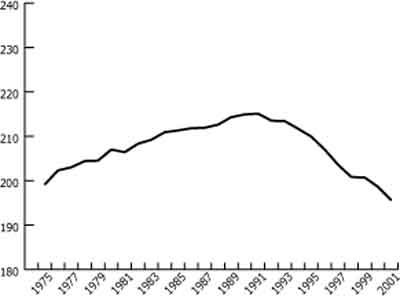
U.S. Cancer Mortality Age-Adjusted Cases per 100,000 Individuals
Now, that’s pretty convincing! Cancer deaths clearly have not been going up in recent years; they’ve been going down. Kudos to medical science. Kudos to the Competitive Enterprise Institute for exposing a fraud. So much for the theory that cancer is a “modern” disease — except for one tiny little problem. The graph starts in 1975. Why not earlier since data is available for those years?
One need go no further than the graphs found in Cancer Trends During the 20th Century, as published in the Journal of Australian College of Nutritional & Environmental Medicine for the answer. See for yourself how cancer rates evolved in Sweden during the 20th Century — and be sure and check out what happens on each graph around the mid-70s where the National Cancer Institute graph begins:
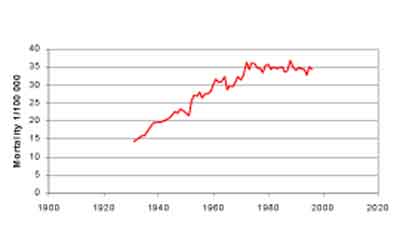
Development of female breast cancer mortality
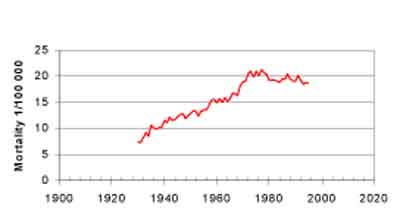
Mortality due to colon cancer in Sweden
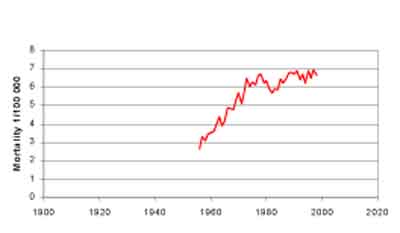
Mortality due to bladder cancer in Sweden since 1956
In fact, what we see is that the incidence of all of these cancers, after years of explosive growth, peaked in the mid seventies. The bottom line is starting a graph on cancer trends in the mid-seventies amounts to cherry picking data. As Benjamin Disraeli was wont to say, “There are three kinds of lies in the world: lies, damn lies, and statistics.” Selectively using cancer data from the mid-70s on amounts to all three kinds of lie at once. Clearly, we can see that although cancer is an ancient disease, its incidence and mortality have skyrocketed in the 20th Century.
And truth be told, not all cancers peaked in the mid-70s. It’s just that you don’t notice that when you fold all cancers together in a single graph. For example:
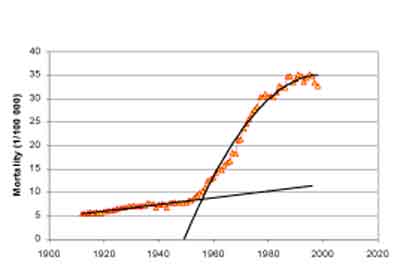
Lung cancer death rates in Sweden
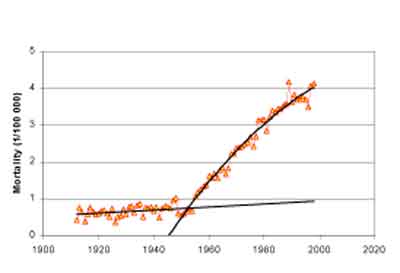
Skin melanoma mortality in Sweden since 1912
And prostate cancer falls sort of between the two models — showing improvement in the mid-70s, only to start rising again after a short respite.
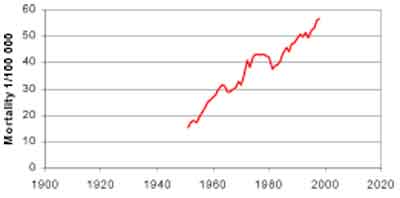
Development of prostate cancer death rates in Sweden since 1951
And then there’s the fact that since 2000, even as other cancers have begun to fade — for reasons that have little to do with better medical care — other cancers such as lymphatic cancer and pancreatic cancer have recently begun to explode to take their place. By the way, why did I just say that much of the improvement in mortality seen in the mid-70s had little to do with improved medical care — even though the medical community and its vast fund raising behemoth try and convince you otherwise? Well consider:
- Much of the improvement in breast cancer incidence and mortality is the result of doctors cutting their prescriptions for hormone replacement therapy over the last several decades. At one time, Premarin was the most prescribed drug in the world. Now that numerous studies have shown that HRT can cause everything from cancer to heart attacks, its rate of prescription has fallen in half. Thus the leveling off of mortality from breast cancer (and ovarian cancer for that matter) over the last few years.
- Colon cancer mortality rates have benefited greatly from the world’s new found obsession with fiber. At one time plentiful in our diets, fiber disappeared with the introduction of fast foods and processed foods. Think no further than white flour. Although white flour has been around for several thousand years, it was primarily an indulgence of the elite until the introduction of supermarkets and prepackaged processed food after World War II. Because whole wheat flour contains fats, it goes bad/rancid far more quickly than white flour. In fact, white flour can last for several years on a store shelf, whereas whole wheat flour (and anything made from it) tends to go rancid in six months. But thanks to the alternative health community’s promotion of high fiber diets (that the medical community finally endorsed after years of mockery), the incidence of colon cancer finally began to level off. (And yes, earlier detection and improved surgical techniques have improved outcomes too.)
- Lung cancer incidence and mortality, of course, is directly related to cigarette smoking. In countries that have significantly cut the use of cigarettes such as the United States, the lung cancer mortality curve has begun to change dramatically. In European countries like Sweden, which have lagged behind in banning cigarettes, not so much yet. And in Asian countries, such as China, that have adopted smoking over the last few decades with a vengeance, the mortality curve is about to take an exponential turn upwards. Incidentally, cigarettes contribute to the onset of many cancers besides lung cancer, including: cancers of the lips, jaw, and throat, along with bladder cancer and pancreatic cancer.
- And sun worshippers and tanning beds have likewise contributed greatly to the sharp increase in skin cancer.
Conclusion
So what do we actually know about cancer?
First, we know that it’s always been with us. People have been getting cancer from the earliest days of their existence (whenever that might be). Heck, most animals get cancer. Even some plants get cancer-like growths. And why not? Essentially, cancer is simply misprogrammed cells that have run amok. Every single day of your life your body produces anywhere from a few hundred to as many as 10,000 misprogrammed cells as part of normal metabolic processes. The trick is that if your immune system is healthy or not overwhelmed by too many rogue cells, it eliminates each and every one of those cells. What we call cancer results when the immune system fails to do its job and allows some of those rogue cells to survive long enough to begin to replicate and “establish a beachhead” in your body. Once the rogue cells develop a support network that allows them to feed themselves, they can start producing bio-chemicals that promote their own existence at the expense of healthy cells. That’s cancer.
Thus, the potential for cancer is in each and every living creature.
We also know quite convincingly, and all nonsensical prehistoric arguments aside, that the incidence of cancer has increased dramatically over the last century. The numbers are there. The data is there. Certainly, doctors can better diagnose tumors now than 50 or 100 years ago, but that’s diagnosis before death. After death when the body is opened up, any pathologist in the last century would recognize a grapefruit sized mass in the colon as cancer. The death would be recorded as cancer. Is it 100% certain? No. It’s certainly possible that doctors as recently as the 1940’s and 50’s were totally incompetent and never noticed tumors when they performed autopsies or treated battlefield wounds when soldiers’ insides lay exposed before them. It’s also possible that the extra 3-7 years that people are living now as opposed to 100 years ago have made a difference. And yes, that’s all that life expectancy has really increased over the last hundred years — once you account for the decline in infant mortality, which dramatically skews the numbers. Perhaps the risk of cancer really does increase fivefold in that small handful of extra years “adults” now live versus 100 years ago. Yes, these things are possible…but not very likely. They can only be argued because as unlikely as they are, you can’t prove that they’re not true — like perpetual motion.
And finally, we absolutely know that the dietary and lifestyle choices we make and our exposure to toxins affect our chances of getting cancer. Again, arguments to the contrary are like arguments for perpetual motion. How do we know this? Quite simply, cigarettes! We know for a fact that in any sample population, cigarette smokers have a far higher incidence of numerous cancers as opposed to non-smokers. Can you absolutely prove the connection (perpetual motion) between cigarettes and cancer? Nope. You can always find someone who’s smoked two packs a day for 50 years and never got cancer. But any rational person knows that if you smoke heavily, your “odds” of getting cancer are dramatically higher.
And likewise, we know that certain dietary choices, chlorinated water, radon gas in our homes, and exposure to numerous toxins and xenoestrogens in our environment significantly increase our risk of cancer. It’s a game of odds — odds that we’d like to move in our favor.
And how do you change those odds?
- Minimize your exposure to toxins and foods that are likely to increase the number of misprogrammed cells in your body.
- Clean out (detox) four times a year to get rid of any toxins that will inevitably make their way into your body.
- Build up your immune system using immune boosters to maximize your body’s ability to eliminate 100% of the rogue cells produced in your body.
- Have regular checkups because even if you do everything right, it’s still possible that one single cell made it through your body’s defenses in a weak moment and took root. Caught early, your chances of defeating the cancer through natural or medical means are good. But remember, cancer is a game of odds, not guarantees.
For more on cancer, check out: Cancer, the Big Lie. Just click below.












The Navaho indian peoples had
The Navaho indian peoples had such a low incidence of cancer that doctors at the time considered them to be immune to it. But after the white man came the caves they used get water from and water their animals in became contaminated from uranium mining. Since then the rate of cancer, diabetes, heart and kidney disease has skyrocketed. I think this says alot.
Many cultures previously
Many cultures previously isolated from Western cultures did indeed have either very low or 0 incidence of cancer, as detailed by physicians living with the people for decades. However, it is quite a leap to jump to uranium mining.
If we look at a century ago, it was the introduction of sugar, white flour and other refined foods which became the new staples to these individuals’ diets. There were hardly any GMOs or non-organic foods or toxins back then. It was the nutrient ratios of these peoples that changed rapidly.
What do you think about the
What do you think about the promotion of toxic sunscreens’ role is in contributing to skin cancer?
Spot on the money Jon, as
Spot on the money Jon, as usual. It’s all about increasing the chances for a better health span and reducing the chances for degenerative disease to strike us down before our time.
What are immune boosters?
What are immune boosters?
Dear Jon.
I don't know where
Dear Jon.
I don’t know where to begin to try and undo all the many misconceptions you harbour.
I read this article above with growing dismay, because I value your expertise and knowledge in your particular sphere of activity very highly. Unfortunately cancer is not one of them and I wish you had availed yourself to my numerous attempts to show you a new way of looking at medicine, which does not have ‘fighting’ and ‘destruction’ at any (high) cost to life as its base.
German New Medicine was founded by Dr. Hamer upon the discovery of 5 Biological Laws of Nature, which do away with the over 5000 (and counting!) hypotheses of the current medical paradigm. Accordingly, “cancer” is a Significant Biological SPECIAL program of Nature and is caused by isolating, unexpected conflict shocks to our Psyche, which then initiates a program appropriate to the perceived crisis.
Prostate ‘cancer’ is caused by a perceived sexual inadequacy (more often than not in older males!), the purpose of which is to produce more fluid. This cancer is, as you obviously know, a type of tumour. It cannot metastasize to bones, because the bones are a younger development in our evolution and are governed by another, younger part of the brain, which is in total control of any and all cancers. There simply is not a situation of “willy nilly out of control of rogue cells”!
There is so much more I could and would tell you, but suffice it to say, please have a thorough look at this website: http://learninggnm.com . Harald.
What an incredible argument.
What an incredible argument. Totally did not expect this gem of information, thank you. I’m reading it throughly.
Great info,
So Cancer's cure
Great info,
So Cancer’s cure is preventive measures & keeping the body in best environment & keep immune system at peak level to fight off these cancer cells that are with us daily. Like exercise and eating ‘Live’ foods or be on enzyme therapy. Keeping the good bacteria in the body & get rid of harmful ones. It is all about the money and there is no money in preventive medicine compare to the money that can be made with an example, Cemo-therapy & radiation.
Very good, Jon.
If I may add
Very good, Jon.
If I may add a few observations:
As the great French scientist Antoine Bechamp observed, cancer and most other disease can be traced to a combination of cellular insufficiencies plus cellular toxins. In other words, failure to properly nourish and hydrate our cells plus the addition of toxins creates a cellular terrain that is ripe for disease.
The increase in the incidence of cancer, as well as other chronic conditions, has pretty much dovetailed with the industrialization of modern society. And it should be noted that the increases have not been limited to just the elderly, but have been seen across all age groups. Around 1900 only a handful of people out of every hundred got cancer. Today, one in every three women and one in every three men are expected to get cancer. What has changed? As you point out, a huge increase in toxins, cigarettes (and the toxic additives they contain) and diet.
The key to avoiding cancer is to live and eat healthily and to take steps to build and maintain a strong natural immune system, which is our natural first line of defense against cancer and other illness.
On a final note, early man often consumed large amounts of meat and our species has evolved over the millenia as one which consumes meats as well as other items. I am a big fan of making sure that we include lots of healthy (mostly raw and organic) veggies and fruits, but I think that it isn’t so much meat itself which has caused increased risks of cancer as it is the type of meat. There is a very big difference between free range meat not subject to feedlot practices such as growth hormones and antibiotics or pesticides and herbicides and the processed meat products and meat found on our grocers shelves.
Just about all of the studies which point to meat eaters having increased risks of cancer and other illness are skewed in a couple of ways. First of all, the studies tend to lump all meat eaters into a single group and secondly people who eat a vegan or predominantly vegan diet tend to be more health conscious as a group. Thus the studies often are comparing processed meat eating couch potatoes with active and healthy vegetable eaters. I don’t think you would find nearly the difference if you compared people who ate some healthy meats and otherwise lived as healthily as a comparable group of people who mostly avoided meats.
So, to me anyway, eating at least some healthy meats is a not a bad thing for most of us – and in fact can be a good thing, considering the value of healthy animal fats in insuring proper utilization of all nutrients. Quite simply it is how we have evolved, and as you know, going 100% vegan can be a tricky proposition for most people.
All the best from your friend,
Tony Isaacs
Cut out the evolution
Cut out the evolution nonsense ‘Isaacs’ – we don’t need any more of your disinfo around here.
There’s a good fella
Yeah there’s invisible people
Yeah there’s invisible people in the clouds and the earth is flat. Don’t you know? Keep your imaginary friends past childhood. It’s good for your “soul”.
1. Did ancient people and
1. Did ancient people and people living before the 20th Century always have access to good nutrition? They may have had organic food, but did they always have the variety they needed?
2. Since man was created about 10 000 years ago, our genes have been deteriorating, allowing mutation /disease to occur more easily, which could have an influence on cancer.
3. How has the population explosion that has occurred in the world in the last few centuries been taken into account in the graphs above? Those graphs match the growth in population which could result in an increase diagnosis of cancer just because there is population growth.
I'm really sorry having to
I’m really sorry having to rebut this comment re. population growth. Statistical data is always occurences out of a given number, as I understand, the numbers referred to above are “per 100,000” – therefore, it has nothing to do with how many people occupy the planet. Must say though, I liked the comment of mankind being roughly 10,000 years old – hope the evolutionists will take this to heart and stop spreading lies.
All the best, Heinz
“man was created about 10 000
“man was created about 10 000 years ago”
Say whaaaat??
When you look at the whole
When you look at the whole sentence, it makes more sense:
“Since man was created about 10 000 years ago, our genes have been deteriorating, allowing mutation /disease to occur more easily, which could have an influence on cancer.”
In the context of deteriorating genes, this seems to be about reducing selection — which started in its current form not with the biological human, but with the “civilized” human. And this started around 10k years ago, give or take.
2. The graffs are death per
2. The graffs are death per person, not just plain death-counts.
Can anyone doubt the truth of
Can anyone doubt the truth of this?
Listening to the voice presentation cements this solid.
I was told in 1992 by my personal health guru that by the year 2009 one of the two of us sitting in this room would have cancer and he added “it won’t be me” !
and told me if I followed his health advice it would not be me either!
Well, I did and I do not have cancer. It is apparent to me that we need to follow a regime of non toxic food, while detoxing at every opportunity and also avoid drugs like the plague and use super foods to nurture your body!
I detox with Activated Liquid Zeolite as well as eating everything that the establishment tells me NOT to eat.
Keep away from low fat and all the nonsense foods. Do not use sun blocks or any of that nonsense! Get out in the sun and fresh air!
Barbara Lockwood
"comment: Zinc (topical
“comment: Zinc (topical cremeis a natural sunscreen; source: Dr. Perry…
"And sun worshippers and
“And sun worshippers and tanning beds have likewise contributed greatly to the sharp increase in skin cancer.”
The sharp increase in skin cancer could have several other reasons
the scaring away from sun by governmental advertising – you need sunshine on your skin so that vitamin D compounds can be formed from cholesterol, vitamin D oritects from skin canceer
the usage of possibly toxic ingredients in sun screens
the pooling of various types of skin alterations under the header of skin cancer.
cancer is coming at such a
cancer is coming at such a high rate now mainly due to vaccines. Animal patients are getting large rates of cancers and they rise with the cumulative damage from vaccines. The human vaccines contain cancer causing viruses and they also dysregulate the immune system. P 53 mutations are being confered with the aluminum salts adjuvants in vaccines……this is the direct link to increased cancers in anything that receives the jab. Cancer viruses both known and contaminates are in these injections. Recently identified are chicken leucosi simian and pig viruses in the children vaccines.Other things do cause cancer, a prehistoric broken bone would easily lead to chronic inflamation and cancer or infection of the injured area but make no mistake the elevation in all of this cancer now is following the unsafe and unecessary vaccine administrations.
Sincerely,
Dr. Jordan
Dr. Jordan, I most certainly
Dr. Jordan, I most certainly agree with you. Of course cancer has always been around, cancer cells are a part of our body, specific damage and or a weakened immune will allow the cancer to rise up and overtake the body. However, up until the twentieth century or thereabouts cancer was relatively rare, while today of course the numbers are rising in huge numbers, particularly in first world countries. Brain cancer in women rose significantly once aspartame was introduced into the food chain and childhood cancers are rising steadily.
Vaccines have a documented history of table injuries and research is showing the onslaught both prenatal and postnatel to infants, giving rise to that mysterious ” mitochondrial dysfunction” one hears bandied about in Vaccine Court as one example. Gardasil is damaging an enormous percentage of our young girls, with our young boys to follow now that FDA has approved Gardasil for boys as young as 9 ! With the CDC approving Flu vaccines containing multiple strains to our pregnant mothers we can look forward to an increase in birth autism spectrum disorders, immune dysfunctions and a generation of chronically sick chilren.If these are not crimes against humanity then one has to ask what is !?!
Sincerely
Dinah Everett Snyder
[email protected]
vaccines are the reason we
vaccines are the reason we have had such a huge rise in cancer. Vaccines cause cancer in anything vaccinated.
Sincerely,
Dr. Jordan
It's about time someone told
It’s about time someone told the truth! Great report. I just have one point of disagreement. Evidence (if you dig deeply like you did in this report) clearly shows it is not “sun worshippers and tanning beds” that give rise to skin cancer, but rather sun fear and suntan lotion, along with lack of fresh fruits and vegetables in the diet. It is vitamin D along with a diet high in antioxidants that protects against skin cancer. Besides blocking the essential solar rays, most sunscreens actually contain many known carcinogens. I’ve observed this for years–if your diet is high in berries and colorful raw produce, and if you increase your sun exposure gradually (and stay out of the sun around noon), you won’t burn. And rarely will get sick from anything.
Another great article as
Another great article as usual Jon! Thanks for all you do
"Quite simply it is how we
“Quite simply it is how we have evolved, and as you know, going 100% vegan can be a tricky proposition for most people.
All the best from your friend,
Tony Isaacs”
Cut out the evolution nonsense please ‘isaacs’, we don’t need any of your disinfo around here thanks, or anywhere else.
There’s a good fella
Very interesting collection
Very interesting collection of opinions. However I would add a new star in the fight of cancer. the definitive explanation of the product along with a excellent history of treatments is found in the book, Outsmart your Cancer, written by Tanya Harter Pierce. The product is called Protocel. Developed by a Jim Sheridan , a chemist who started work on it in 1940s and finally perfected it in the 1980s. He struggled for years to get approval without sucess even though the National Cancer Institute tested itand found it extemely effective against all cancer lines tested. Protocell was then given away free (20,000 bottles) to avoid government restrictions. Eventully the product originally called Cancel was allowed only because it was marketed as a cell cleanser. The book is the best way to investigate this. Protocel functions in an entirely different way and is stunning inability to killcancer anywhere in the body and is totally non-toxic. This deserves a serious look
When thinking outside the box
When thinking outside the box and comparing cancer rates today to those from the ancient times or the begining of the 20th century, I wonder why Jon and other scientist do not use several remote tribes and populations that exist today and still eat traditionally and are predominantly toxin free? Comparing cancer incidence in these populations to the rates in the “modern and advanced” societies should help best in proving the point.
Ahh! But there are no
Ahh! But there are no predominantly “toxin free” tribes any more. Check out the Canadian Toxic Nation study. http://www.jonbarron.org/detox/program-inescapable-toxins-full-body-cleanse
Why no mention in the article
Why no mention in the article of the other 2000 nuclear tests conducted since the Hiroshima/Nagasaki bombs in 1945? Radioactive material from these is well dipersed in the environment. Liquid substances such as wine have even been dated by the finding of ceasium 127 in the contents of bottles falsely purported to be older than 1945.
Good comment.
Good comment.
The increases in cancer began in the mid 1940’s. That’s when the nuclear tests started. I came upon this information from researching what in a tobacco plant causes cancer. This led to my discovery of cheap uranium based fertilizers used on crops by tobacco companies. This eventually led me to researching the 2000 tests you mentioned and the amount of radioactive fallout introduced into our environment and the partial destruction of the ozone layer.
Let's not try and dismiss
Let’s not try and dismiss this or that toxin, just because some other toxin cannot be avoided. It’s about finding them and reducing our exposure, without being overly zealous about it and driving ourselves insane.
Let’s try to avoid those that we can actually avoid and increase our chances to survive, even if by a mere percent. That percent represents an infant too many diagnosed with leukemia.
To do that, we must stop taking sides against each other. We can simply acknowledge that various toxins affect our ability to fight undesired cells and that we can do things better.
what about the "vitamin b17"
what about the “vitamin b17” ? No one mentioned that, supposedly betas from cancer cells actively release the toxic compounds present in many natural foods like apples and apricots killing cancer cells. Makes perfect sense that there is way in nature to keep cancer under control in animals. Adding to that there’s the possibility that ancient people were less picky and would gladly eat the bitter/hard fruit kernels/seeds… I don’t know what is true or not because we live in a world where truth is manipulated at every corner but it seems hard to believe that a few seeds per day would kill you. I’ve been eating apples and apricots and it’s seeds for years and until now I’m fine, of course that might not be case tomorrow but surely it isn’t worse than all the toxicity around us.
Hello Someone,
Actually, we
Hello Someone,
Actually, we have an entire blog on the subject: http://www.jonbarron.org/detox/bl061025/health-blog-laetrile-b17
I have read how dried fruit,
I have read how dried fruit, should as dried prunes, can actually contribute to cancer. It is because of acrylimides. How do we protect ourselves from this kind of toxicity even when eating organic products? Even in prehistoric time, there must have been ancestors eating dried fuit. Thanks.
Animal studies have found a
Animal studies have found a weak association between acrylamide and premenopausal tumors. But keep in mind:
Also, it requires heat of over boiling temperatures for its formation – although one study found that it MAY form in very small amounts in dried fruit. However, subsequent heating of that dried fruit such as in making prune juice, which requires boiling, could increase the amount. But again, this is merely indicated, not proven. http://www.ncbi.nlm.nih.gov/pubmed/17687696
The bottom line, though, is that there is zero evidence that eating dried prunes in any way actually increases the incidence of cancer. In fact, all studies indicate the opposite — that prunes are cancer protective, for example http://www.ncbi.nlm.nih.gov/pubmed/17190111
If you want to get a broad
If you want to get a broad overview of everything that is involved in healing from cancer holistically, this is a must-watch documentary – “Cancer is curable Now”
Interesting stuff –
Interesting stuff – especially the graphs
The effect of radiation on human health, especially cancers, is a very controversial subject.
With the Fukushima situation ongoing I wondered about the history of cancer.
In hardly any public debates on cancer is radiation ever quoted as a cause or catalyst.
I am looking here at graphs that all begin to take off around 1945 which was when the first A bombs were detonated followed by 1000’s of nuclear tests and a few nuclear accidents.
Why is the effect of radiation on cancer rates a taboo subject or has it just been missed/ignored/covered up.
Hi Jon,
Hi Jon,
For days I’ve tried to track down this kind of a historical overview that took account of the arguments-going-round-and-round. Thank you so much!
For what its worth I’ve attended a couple of seminars with Dr. Paul Clayton and he used exactly your method. The period he used was in fact the Victorian times in UK. That period is fairly well-documented too and about 90 percent of our “life style diseases” weren’t present at that time. People ate lots of calories (about 4000 if I remember correctly) because they were physically active, and they got very good, food nutrition-wise. Plenty of natural vitamins, polyfenols, fish (omega-3) and beta-glucans.
He also refuted the often heard argument that “cancer has always been with us and it’s just because we get older.” Corrected for infant/birth mortality, as you also do correctly, the Victorian man and woman could expect to live as long as us.
The main difference is simply this. Though we managed to kick all the infectious diseases that killed Victorians, we just swapped in life style diseases to kill us off.
So what pulled Victorians down wasn’t cancer, heart disease and the usual suspects from our time. It was infection, accident, injury and so on. Other than those harsh realities of life back then they were quite healthy and had only 10 percent of our life style diseases.
Best regards, Jesper
You have left out the
You have left out the accumulated effects of low level ionizing radiation. The incidence graphs peaking in in 1970 and remaining somewhat stable to decreasing correlates well with the peaking of atmospheric nuclear testing in the early 60’s.
Your statement that over the
Your statement that over the past 100 years, after adjusting for infant mortality, lifespan has increased 3 to 7 years is not believable. Since penicillin, deaths from bacterial infection, most notably pneumonia and other lung diseases, have been almost eradicated in the developed world. Please check your data.
Joseph in Missoula
It may not be believable, but
It may not be believable, but it’s true. The following–as just one example among dozens–is extracted from the National Bureau of Economic Research.
“Except for a 10-year period between 1955 and 1965 when the mortality rate was essentially flat, mortality rates have declined at the relatively constant rate of approximately 1 to 2 percent per year since 1900…In the first four decades of the twentieth century, 80 percent of life expectancy improvements resulted from reduced mortality for those below age 45, the bulk of these for infants and children.
“During the first half of the century, changes in the ability to avoid and withstand infectious diseases were the prime factors in reducing mortality. Infectious diseases were the leading cause of death in 1900, accounting for 32 percent of deaths. Pneumonia and influenza were the biggest killers. Therefore, improved nutrition and public health measures, particularly important for the young, were vastly more important in this period than medical interventions. Better nutrition allowed people to avoid contracting disease and to withstand disease once contracted; public health measures reduced the spread of disease. During this period, reduced infant mortality contributed 4.5 years to overall improvements in life expectancy; reduced child mortality contributed nearly as much, and reduced mortality among young adults added about 3.5 years.”
Fact: not only has cancer
Fact: not only has cancer death increased in the last century, its occurred despite cancer treatment being far more available. What you don’t see refelrcted in those charts are successfully treated cancer cases or people who beat cancer and died if something else. Fact is, those deaths on the charts would be even higher if treatment was the same as what was available over 100 years ago.
But you can keep on kidding everyone the rates of cancer death didn’t increase or are not as serious as they really are in the past decade. Or that they aren’t increasing. Cancer that’s been treated is still a case of cancer not counted in that chart.
I cannot find it again, but I
I cannot find it again, but I saw a cancer graph from 1900 to the present that made a clear upward move in 1945, and continued upward at the same angle into the present. Having lived through WWII as a child, I am very aware of 1945. That was the year my father came home from the war, after they nuked Hiroshima and Nagasaki, having set off the first test nuke in New Mexico. You may think that the problem of radioactivity is local and down wind. No, everything the nuke touches is instantly vaporized. It all goes up in a mushroom cloud into the stratosphere, to be blown around the earth and and be distributed equally at that latitude.We set off 500 more nukes above ground in the Southwest, and the another 500 underground (most of them vented to the surface), Other countries followed our example, including North Korea today.
Get your vitamin C intake up to 1000 mgs per day. I also take C60 everyday; prevents cancer in rats.